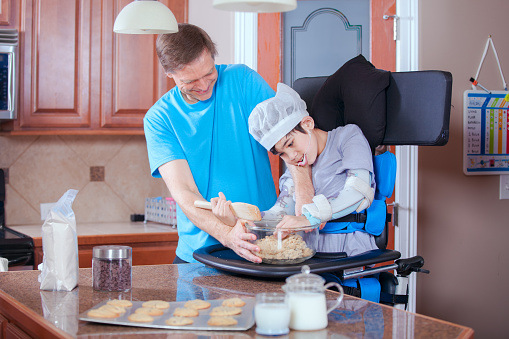- Providing Helpful Healthcare Products Since 1999 | Our Hours: 8 AM - 5 PM CST Mon - Fri
- +1-877-750-0376
No Limits in the Kitchen: Cooking With Limited Mobility

Making Your Place a Safe Space
March 31, 2017
Keeping Your Mind Active
May 8, 2017For the new cook or someone who doesn’t enjoy cooking, kitchen duty can be difficult. Those with disabilities may find cooking in the kitchen especially challenging. We are going to let you in on some of the secrets of cooking with disabilities, that will help make your or your loved one’s time in the kitchen a little less difficult.
The most common kitchen problems faced by those with disabilities are standing and reaching limitations and issues with using one side of their body. An article on the kitchn.com provides helpful cooking strategies for those who have a physical disability. These tips were gathered from two cooks with physical disabilities, a family member, a chef, and an occupational therapist. We are going to list some of them below.
- Plan ahead of time to save time, money, and hassle.
- Break the process down; have everything laid out before starting to cook.
- Make sure your kitchen is organized in such a way that the food and cooking items are easily accessed.
- If you tire easily take frequent small breaks and/or keep a chair or stool nearby to sit down.
- Don’t worry about perfection. Just enjoy the process of cooking.
Kitchen Design
The layout/design of the kitchen plays an important role in helping the disabled navigate efficiently and effectively in this area. Counter space and height of the countertops and appliance type are critical issues to consider. Having a long continuous counter space and lowered countertops is important for those with limited mobility and limitations in reaching as well as for those in wheelchairs. The type of appliances that are installed in the kitchen can make a world of difference to those in wheelchairs and those with arthritic conditions or other conditions that make it hard for them to turn knobs or pull levers.
An oven that has a side swing door may be helpful for someone in a wheelchair or one with the controls on the front of the stovetop versus the top back. Two burner stoves are also an option for those who might have trouble reaching a back burner.
Side by side refrigerators are more easily accessed by wheelchair users than the standard fridge. The doors of a side by side are shorter and allow those in wheelchairs more reach in access than is provided by top freezer doors. Compact refrigerator models offer accessible height mounting.
Adaptive Kitchen Aids
Specially designed kitchen aids can take the stress out of your cooking experience. Easy grip knives and utensils make slicing, peeling, chopping, and carving more comfortable and less stressful for those who have arthritic or other conditions that weaken the hands or wrists.
For someone with the use of only one hand, preparing, chopping, and cutting food can be an especially difficult task. Adaptive cutting boards can ease the strain of this process. These boards have two aluminum spikes that keep the food secured and two food guards that keep the food from sliding off the edges.
We hope these tips and products will help take the limits off of you in the kitchen. Happy cooking!
© Copyright 2017 The Wright Stuff, Inc. Articles may only be redistributed in its unedited form. Written permission from The Wright Stuff, Inc. must be obtained to reprint or cite the information contained within this article.

